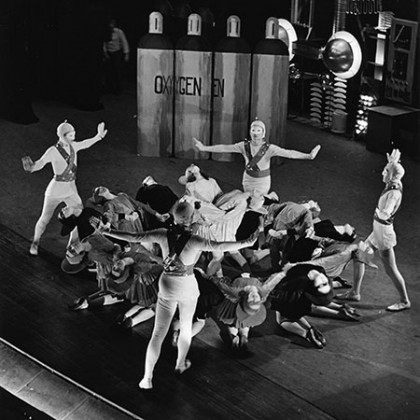When Peabody Dance celebrates its centennial March 26 to 29, it's not only marking 100 years of offering dance instruction at Peabody Preparatory, the community school for the performing arts housed at the Peabody Institute of Johns Hopkins University. It's advancing its unique ability to provide young dancers with the tools to become creative artists.

Image caption: Carol Lynn’s Peabody Dance students perform in the 1939 The Chemical Ballet, a collaboration with Johns Hopkins chemistry Professor Donald H. Andrews.
Image credit: Peabody Archives
Collaborations have been part of Peabody Dance's process since its inception, and last summer students and faculty worked out ideas that will debut during the centennial weekend, which includes a conference, historical exhibition, films, and a pair of performances.
The collaborative piece Dear Mother premieres that weekend, and some of its choreography grew out of Constance Dinapoli's intensive classes. Dinapoli, the artistic coordinator of contemporary dance at the Preparatory, asked her students to recall their earliest memory. She invited those students to consider how that memory made them feel, and how they might express that emotion with their bodies. "I looked at their movement, and I helped them arrange it into more of a dance phrase," Dinapoli says.
Peabody Dance is one of the oldest dance training centers in the country, offering technical training in classical ballet and modern dance. Today, it also strives to give its students opportunities to work with other artists, not just learn from them. Melissa Stafford, its director, says that the first dance class that the Peabody Institute offered, in December 1914, was eurythmics, a way to teach musicians and music teachers about music through movement. That first class "put us on an innovative path and led to a collaborative production of Orpheus and Eurydice in 1922 that had 200 dancers, musicians, and singers," Stafford says.
Ever since, Peabody Dance has embraced collaborative projects that bring student dancers into creative contact with not only dance professionals but musicians and visual artists—and the occasional scientist. Stafford mentions The Chemical Ballet, a 1939 collaboration between dancer and educator Carol Lynn, who later served as Peabody Dance chair from 1947 to 1970, and a Johns Hopkins University chemistry professor, Donald H. Andrews, in which dancers portrayed different chemicals and their reactions. The dance was performed at the annual meeting of the American Chemical Society in Baltimore.
Collaborative opportunities make Peabody Dance unique among training centers, Stafford says. "My brother and sister have professional dance careers, and we had world-class ballet training, but we never had the opportunity to become part of the collaborative process while still students," Stafford says. "Our students work with choreographers, répétiteurs, visual artists, composers, and musicians, and learn how artists negotiate the creative process. And that's something that's happened at Peabody from the very beginning."
For a full schedule of Peabody Dance centennial events, click here.
Posted in Arts+Culture, Student Life
Tagged peabody centennial, peabody dance







